Mathematical Treasure: Leibniz's Papers on Calculus

Gottfried Wilhelm Leibniz (1646-1716) was a true polymath recognized for his excellence in many fields, particularly philosophy, theology, mathematics, and logic. He is considered a cofounder, along with Isaac Newton, of the Calculus. In 1682, Leibniz, together with a fellow German philosopher and scientist, Otto Mencke (1644-1703), founded a scholarly journal, Acta Eruditorum [Reports of Scholars], in Leipzig. The journal was intended for the German-speaking regions of Europe, despite being written almost entirely in Latin. Acta Eruditorum, a monthly journal, would become the vehicle for much of the mathematical publication of Leibniz and the Bernoullis and would eventually be the forum through which Leibniz defended his priority in the development of calculus.
According to J. J. O’Connor’s and E. F. Robertson’s biography in the MacTutor History of Mathematics Archive, Leibniz “developed the basic features of his version of the calculus” while living in Paris during the 1670s:
In 1673 he was still struggling to develop a good notation for his calculus and his first calculations were clumsy. On 21 November 1675 he wrote a manuscript using the \(\int f(x)\,dx\) notation for the first time. In the same manuscript the product rule for differentiation is given. By autumn 1676 Leibniz discovered the familiar \(d(x^n)=nx^{n-1}dx\) for both integral and fractional \(n.\)
Leibniz began publishing his calculus results during the 1680s. We present on the following pages three famous articles on the Calculus, published by Leibniz in Acta Eruditorum in 1684, 1686, and 1693:
- "Nova Methodus pro Maximis et Minimis…" (1684)
- “De geometria recondite et analysi indivisibilium atque infinitorum...” (1686)
- “Supplementum Geometrie Dimensorie…” (1693)
The portrait of Leibniz above is from the Convergence Portrait Gallery. It appears there courtesy of the Dibner Library of Science and Technology, The Smithsonian Institution Libraries, and its usage must conform to the Library’s rules and standards. The images in the following three pages of this article are used through the courtesy of the Lilly Library, Indiana University, Bloomington, Indiana. You may use them in your classroom; for all other purposes, please seek permission from the Lilly Library.
Reference
J. J. O’Connor and E. F. Robertson, “Gottfried Wilhelm von Leibniz,” MacTutor History of Mathematics Archive.
Mathematical Treasure: Leibniz's Papers on Calculus - Differential Calculus
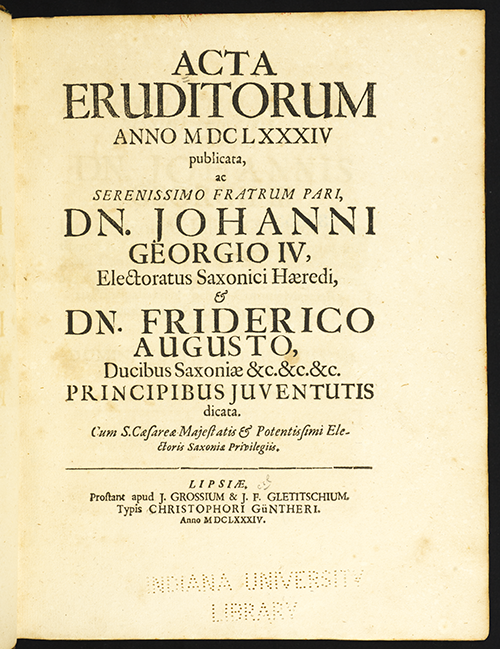
Above is the title page for the 1684 volume of Acta Eruditorum.

The first page of the October 1684 issue (number X) of Acta Eruditorum is shown above. Leibniz's first article describing the Calculus appeared on pages 467-473 of this issue.

A plate of diagrams for Leibniz's article on the Calculus was placed opposite page 467, the first page of the article. The reader is referred to it in the very first line of the article: note "TAB.XII," or Table XII, in the righthand margin of page 467, below.

Leibniz’s first article describing the Calculus was published in October, 1684. The article, “Nova methodus pro maximis et minimis, itemque tangentibus,…, & singulare pro illis calculi genus” [“New method for the maximum and minimum, and also tangents, …, and a singular type of calculus for them”], was a definitive exposition of his differential calculus. The adjective "singulare" is often translated as "remarkable": "a remarkable type of calculus for them." The initials "G.G.L." are for Gottfried Wilhelm Leibniz with Wilhelm latinized to Guilielmus.
Do you recognize the product and quotient rules for differentials in the second paragraph above? It helps to know that "aequ." is used for "equals" or "=". The equals sign, =, is used in Leibniz's articles from 1686 and 1693 on the next two pages.
The remainder of the article is presented below in its entirety. A translation of the article from Latin to English can be found in D. J. Struik's A Source Book in Mathematics (1200-1800), pp. 271-280.

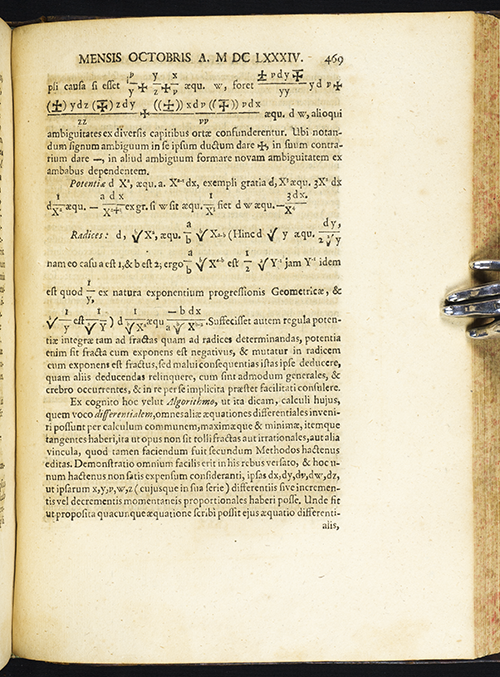
On the page above (page 469), Leibniz discussed differentials of powers (potentiae) and of radicals (radices). He also named the methods discussed in his article "differential calculus": see "calculi hujus, quem voco differentialem," or "this calculus, which I call differential" at the start of the last paragraph.




The images above are used through the courtesy of the Lilly Library, Indiana University, Bloomington, Indiana. You may use them in your classroom; for all other purposes, please seek permission from the Lilly Library.
Reference
D. J. Struik (editor), A Source Book in Mathematics (1200-1800), Harvard University Press, Cambridge, Mass., 1969.
Mathematical Treasure: Leibniz's Papers on Calculus - Integral Calculus

Above is the title page of the 1686 volume of Acta Eruditorum.
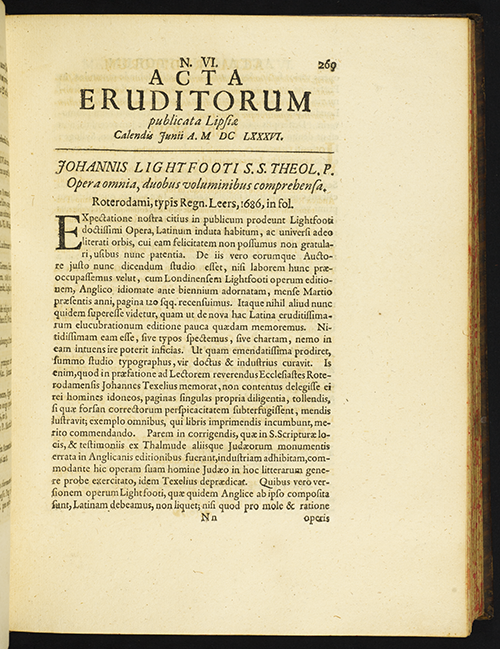
This is the first page of the June 1686 issue (Number VI) of Acta Eruditorum, in which Leibniz published a second article describing the Calculus on pages 292-300.

In the June 1686 issue of Acta Eruditorum, Leibniz (G.G.L.) published “De geometria recondita et analysi indivisibilium atque infinitorum,” or "On a hidden geometry and analysis of indivisibles and infinites." In this article we find the first public occurrence of the integral sign \(\int\) and a proof of “The Fundamental Theorem of Calculus.” A partial translation from Latin to English of the article can be found in D. J. Struik's A Source Book in Mathematics (1200-1800), pp. 281-282. The remaining pages of the original article appear below.
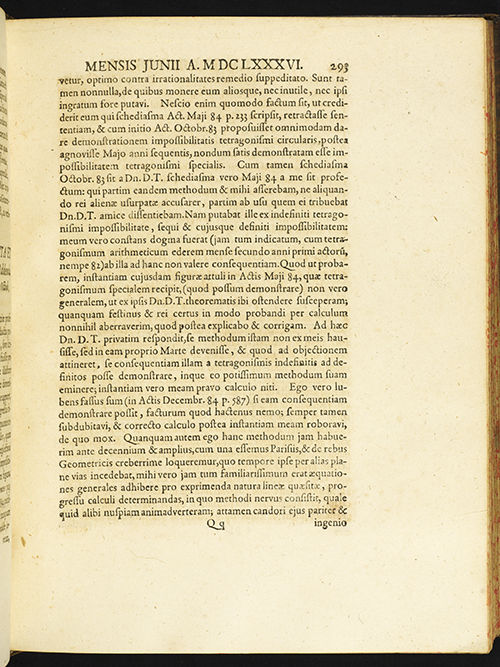
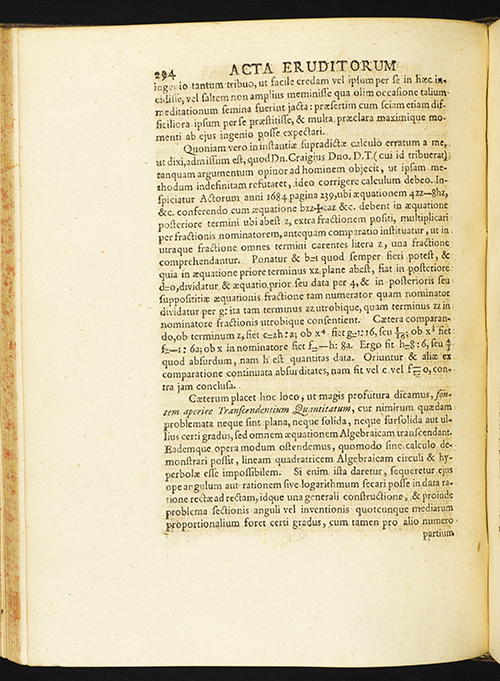
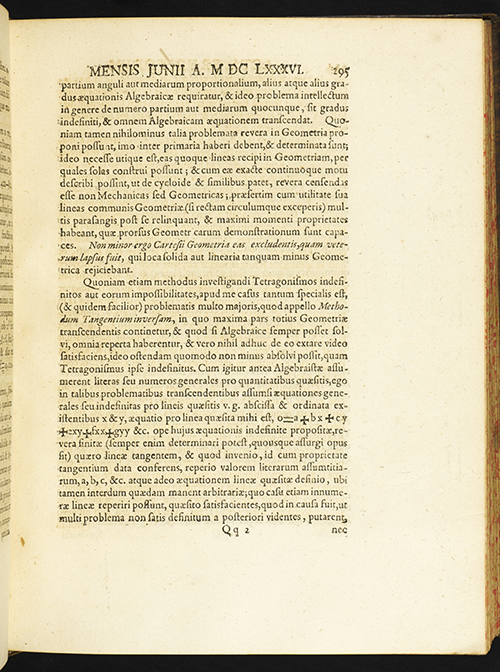


On page 297 above, Leibniz pointed out that \(p\,dy=x\,dx\) implies \({\int{p}}\,dy={\int{x}}\,dx\), and therefore, in particular, \(d\left({\frac{1}{2}}xx\right)=x\,dx\) implies \({\frac{1}{2}}xx={\int{x}}\,dx.\) He then wrote, "... sums and differences or \({\int}\) and \(d,\) are reciprocals" ("summae & differentiae seu \({\int}\) & \(d,\) reciprocae sunt"), and concluded from his preceding equations that \({\int{p}}\,dy={\frac{1}{2}}xx.\)


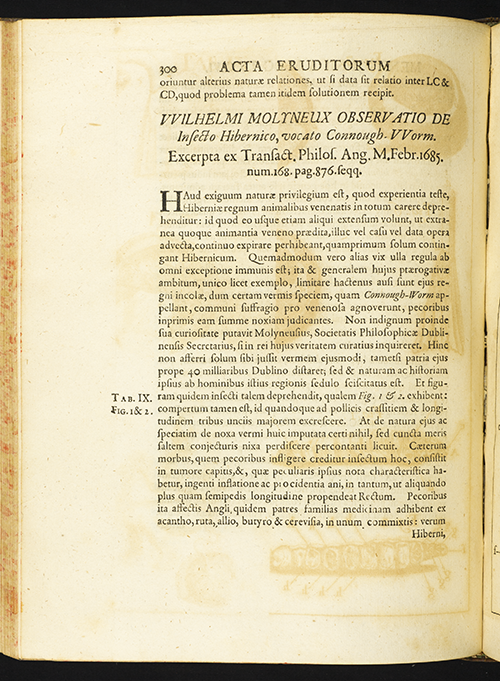
The images above are used through the courtesy of the Lilly Library, Indiana University, Bloomington, Indiana. You may use them in your classroom; for all other purposes, please seek permission from the Lilly Library.
Reference
D. J. Struik (editor), A Source Book in Mathematics (1200-1800), Harvard University Press, Cambridge, Mass., 1969.
Mathematical Treasure: Leibniz's Papers on Calculus - Fundamental Theorem

Shown above is the title page of the 1693 volume of Acta Eruditorum.
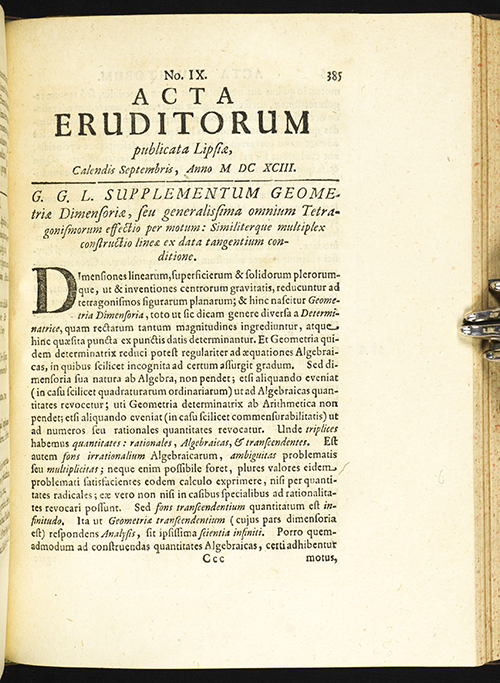
The September 1693 issue (No. IX) of Acta Eruditorum, began with an article by Leibniz (G.G.L.). In “Supplementum Geometriae Dimensoriae…” ("Supplement on geometric measurement"), he showed that the general problem of quadrature can be reduced to finding a curve that has “a given law of tangency.” A modernization of this accomplishment would be showing that the general problem of definite integration can be reduced to finding a function that has a given derivative – that is, finding an antiderivative function – which is essentially the Fundamental Theorem of Calculus. A partial translation of the article from Latin to English can be found in D. J. Struik's A Source Book in Mathematics (1200-1800), pp. 282-284.
For diagrams accompanying the article, see the second page below, "Tab[ula] V," inserted between pages 386 and 387.
For modern calculus notation, see page 390.


Figures 1-3 in Table V, above, are referenced in the margins of the pages that follow.
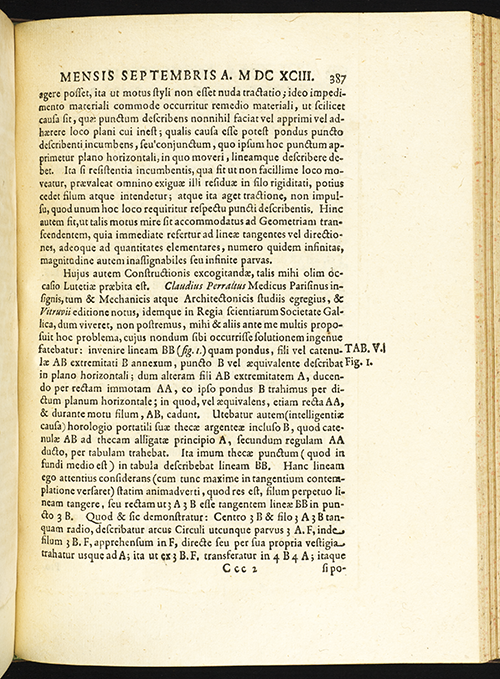
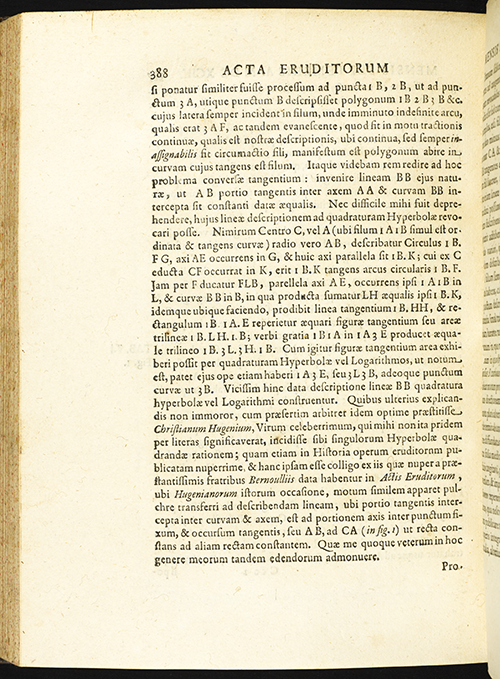


On page 390, above, at the start of the first full paragraph, Leibniz seemed to get to the mathematical point of his article, writing, "I shall now show the general problem of quadratures [integration] to be reduced to the invention [finding] of a line [curve] having a given law of declivity [tangency]." Also on page 390, be sure to find the integral sign \(\int\) near the bottom of the page, in the sentence, "Ergo \(a\,dx=z\,dy,\) adeoque \(ax={\int{z}\,dy}={\rm{AFHA,}}\)" or "Therefore, \(a\,dx=z\,dy,\) so that \(ax={\int{z}\,dy}={\rm{AFHA.}"}\)


The images above are used through the courtesy of the Lilly Library, Indiana University, Bloomington, Indiana. You may use them in your classroom; for all other purposes, please seek permission from the Lilly Library.
Reference
D. J. Struik (editor), A Source Book in Mathematics (1200-1800), Harvard University Press, Cambridge, Mass., 1969.